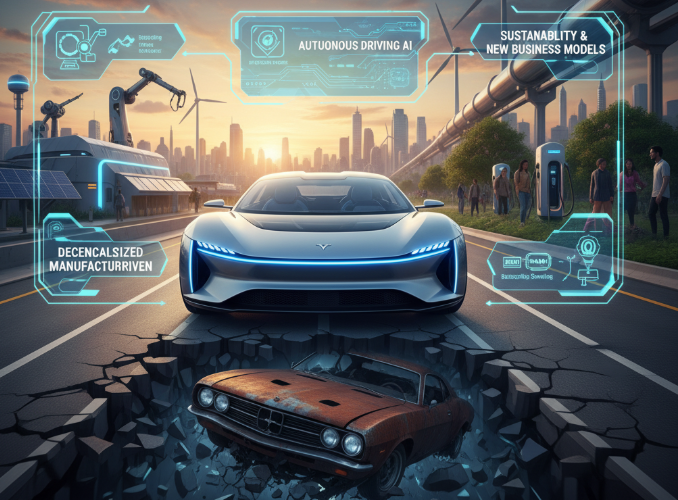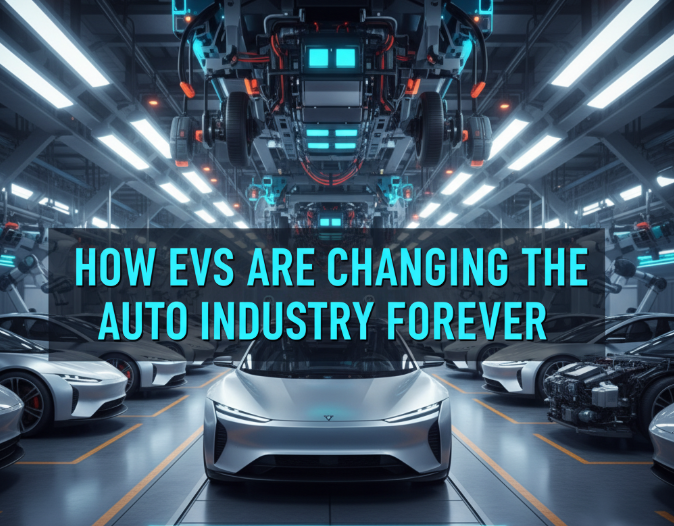Introduction: The Silent Revolution on Wheels
The auto industry has always been about progress—moving faster, going farther, and building better machines. But nothing has shaken it quite like the rise of electric vehicles (EVs). For decades, gas-powered engines ruled the roads, defining speed, power, and design. Today, EVs are rewriting those rules. They’re not just a new type of car; they’re reshaping how vehicles are built, sold, and even powered.
From Tesla’s bold rise to governments worldwide pushing green policies, the shift toward EVs is massive. And it’s not slowing down. By 2030, experts predict that more than half of new cars sold globally will be electric. This is not just a trend—it’s a permanent change. Let’s explore how EVs are transforming the auto industry forever.
The Rise of Electric Cars: From Niche to Mainstream
Not long ago, EVs were seen as futuristic toys for the rich or eco-conscious. Today, they’re becoming the default choice for millions of drivers.
Why EVs Went from “Weird” to “Wanted”
- Falling battery costs: Batteries once made EVs too expensive, but prices have dropped by over 80% in the past decade.
- Longer range: Early EVs could barely drive 100 miles per charge; now some models go over 400 miles.
- Government incentives: Tax credits, rebates, and fuel savings make EVs financially attractive.
- Better performance: EVs accelerate faster, handle smoother, and require less maintenance than gas cars.
How EVs Are Reshaping Car Design and Manufacturing
Simplified Engineering
Traditional gas engines have thousands of moving parts. EVs? Much simpler. They use electric motors, which:
- Have fewer parts to break.
- Need less maintenance (no oil changes, no spark plugs).
- Are cheaper to assemble once scaled.
This shift means car companies can cut costs, speed up production, and focus on design innovation rather than constant engine repairs.
New Design Freedoms
Without bulky engines, EVs give designers more freedom:
- Flat floors thanks to battery packs allow roomier interiors.
- Frunk (front trunk) space for extra storage.
- Sleeker looks as aerodynamics become a bigger priority.
EVs are changing not only how cars are built but how they look and feel.
The EV Impact on Big Auto Brands
Legacy Automakers Go Electric
Companies like Ford, GM, Toyota, and Volkswagen once resisted EVs. Now, they’re pouring billions into them:
- Ford launched the Mustang Mach-E and F-150 Lightning.
- GM pledged to go all-electric by 2035.
- Volkswagen aims to dominate EVs in Europe.
Tesla: The Game-Changer
Tesla didn’t just build EVs—it changed the industry mindset. Its cars proved that EVs could be cool, fast, and desirable. This forced traditional automakers to adapt or risk falling behind.
Charging Stations: The New Gas Stations
Building the Infrastructure
For EV adoption to work, charging networks must rival gas stations. Governments and private companies are racing to install chargers:
- Fast chargers can power a car in under 30 minutes.
- Home charging is becoming the norm, letting people “refuel” overnight.
- Workplace charging is growing, giving employees free or cheap electricity while they work.
The Business of Charging
Charging stations are becoming a new profit stream. Just as gas stations thrived in the 20th century, charging hubs will define the 21st.
The Green Advantage: Why EVs Are Key to a Cleaner Future
Emission Reductions
EVs produce zero tailpipe emissions. Over their lifetime, they cut carbon pollution significantly compared to gas cars, especially when powered by renewable energy.
Boosting Renewable Energy
As EVs grow, they encourage investment in solar, wind, and hydro power. Some EVs even support vehicle-to-grid (V2G) technology, where cars can send electricity back to the grid during peak demand.
EV Economics: Lower Costs, Higher Value
Fuel Savings
- Electricity is cheaper than gas in most regions.
- EV owners save thousands per year by skipping the pump.
Maintenance Savings
EVs skip many costly services:
- No oil changes
- Fewer brake repairs (thanks to regenerative braking)
- Longer-lasting motors
Resale Value
As demand rises, EVs hold their value better, especially popular models like Tesla or Hyundai Ioniq 5.
EVs and Jobs: A Shifting Workforce
The Changing Auto Workforce
EVs require different skills to build and maintain:
- More electrical engineers
- Fewer mechanics for engine repair
- Growth in battery manufacturing
The Battery Boom
Gigafactories (massive battery plants) are opening worldwide. These plants are creating new jobs while shifting supply chains away from oil and toward lithium, nickel, and other raw materials.
Challenges EVs Still Face
Range Anxiety
Many drivers still fear running out of charge on long trips. While ranges are improving, this remains a psychological barrier.
Charging Access
Urban residents without garages face challenges charging at home. Public networks need to expand further.
Battery Recycling
Millions of EV batteries will eventually need recycling. Companies are investing in ways to recover valuable metals and reuse them.
EV Innovations That Are Shaping the Future
Solid-State Batteries
- Offer more energy, faster charging, and longer lifespans.
- Could make EVs cheaper and safer.
Wireless Charging
Some EVs may soon charge just by parking over a pad or even while driving on special roads.
Autonomous Driving
EVs and self-driving tech often go hand in hand. Companies like Tesla and Waymo are pushing toward fully autonomous electric cars.

EVs Beyond Cars: Trucks, Buses, and More
Electric Trucks
- Tesla Semi and Rivian trucks are entering freight hauling.
- Lower fuel and maintenance costs attract logistics companies.
Electric Buses
Cities worldwide are adopting electric buses to cut pollution and noise in urban areas.
Electric Two-Wheelers
In Asia and Africa, electric scooters and motorcycles are transforming daily commuting.
Table: EVs vs Gas Cars at a Glance
| Feature | Electric Vehicles (EVs) | Gas Vehicles (ICE) |
|---|---|---|
| Fuel Cost | Lower (electricity) | Higher (gasoline) |
| Maintenance | Minimal (fewer parts) | Frequent repairs |
| Environmental Impact | Cleaner, zero emissions | High emissions |
| Performance | Instant torque, smooth | Slower acceleration |
| Resale Value | Increasing | Declining |
How EVs Are Reshaping Consumer Habits
- Ownership Models: Subscription-based EV services are emerging.
- Smart Apps: EVs connect with apps for real-time battery monitoring.
- Community Charging: Neighborhoods are setting up shared charging spots.
The Global Picture: EV Growth Worldwide
Europe
- Aggressive policies are banning new gas cars by 2035.
- Norway leads, with over 80% of new cars sold being electric.
USA
- Government incentives are fueling rapid EV growth.
- Tesla dominates, but Ford, Rivian, and GM are catching up.
China
- The world’s largest EV market.
- Local brands like BYD and NIO are challenging global giants.
Conclusion: The Road Ahead Is Electric
Electric vehicles are more than just cars—they’re symbols of change. They’re shifting how we build vehicles, how we fuel them, and how we think about transportation itself. The auto industry is being reshaped from the ground up, from factories to fueling stations, from consumer habits to global policies.
Gas cars defined the last century. EVs will define this one.
The transformation isn’t just coming—it’s already here. The auto industry will never be the same again, and the road ahead is electric.

Leave a Reply